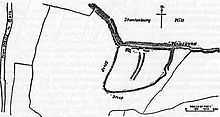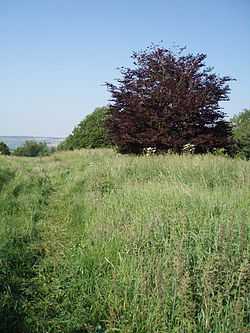Stantonbury Camp
| Stantonbury Camp | |
|---|---|
|
The top of Stantonbury Hill | |
| Location | Marksbury, Somerset, England |
| Coordinates | 51°22′15″N 2°28′20″W / 51.37083°N 2.47222°WCoordinates: 51°22′15″N 2°28′20″W / 51.37083°N 2.47222°W |
| Built | Iron Age |
 Location of Stantonbury Camp in Somerset | |
Stantonbury Camp is the site of an Iron Age hillfort near Stanton Prior within the parish of Marksbury in Somerset, England. It is a Scheduled Ancient Monument.
Background
Hill forts developed in the Late Bronze and Early Iron Age, roughly the start of the first millennium BC.[1] The reason for their emergence in Britain, and their purpose, has been a subject of debate. It has been argued that they could have been military sites constructed in response to invasion from continental Europe, sites built by invaders, or a military reaction to social tensions caused by an increasing population and consequent pressure on agriculture. The dominant view since the 1960s has been that the increasing use of iron led to social changes in Britain. Deposits of iron ore were located in different places to the tin and copper ore necessary to make bronze, and as a result trading patterns shifted and the old elites lost their economic and social status. Power passed into the hands of a new group of people.[2] Archaeologist Barry Cunliffe believes that population increase still played a role and has stated "[the forts] provided defensive possibilities for the community at those times when the stress [of an increasing population] burst out into open warfare. But I wouldn't see them as having been built because there was a state of war. They would be functional as defensive strongholds when there were tensions and undoubtedly some of them were attacked and destroyed, but this was not the only, or even the most significant, factor in their construction".[3]
Description

The hillfort, which is at the top of an isolated outcrop of Oolitic Limestone,[4] close to the A39 road is on the route of the Wansdyke.[5] Wansdyke (from Woden's Dyke) is an early medieval or possibly defining an Roman boundary with a series of defensive linear earthworks in the West Country of England, consisting of a ditch and a running embankment from the ditch spoil, with the ditching facing north. Its construction is attributed to the pagan Saxons, probably in the late sixth century.[6] It runs at least from Maes Knoll in Somerset, a hillfort at the east end of Dundry Hill south of Bristol, to the Savernake Forest near Marlborough in Wiltshire.
Several iron agricultural implements including blades of sickles or pruning hooks and the iron tip from an ard, which are now reside in the collection of the British Museum.[7]
The site is on the English Heritage Heritage at Risk Register as being in danger of deterioration because of extensive animal burrowing.[8]
See also
References
- ↑ Payne, Andrew; Corney, Mark; Cunliffe, Barry (2007), The Wessex Hillforts Project: Extensive Survey of Hillfort Interiors in Central Southern England, English Heritage, p. 1, ISBN 978-1-873592-85-4
- ↑ Sharples, Niall M (1991), English Heritage Book of Maiden Castle, London: B. T. Batsford, pp. 71–72, ISBN 0-7134-6083-0
- ↑ Time Team: Swords, skulls and strongholds, Channel 4, 2008-05-19, retrieved 16 September 2009
- ↑ "Area 6 Hinton Blewett and Newton St Loe Plateau Lands". Rural Landscapes. Bath and North East Somerset Council. Retrieved 26 January 2011.
- ↑ "Stantonbury Hill". Wansdyke Project 21.
- ↑ Cyril and Aileen Fox, "Wandyke reconsidered", Archaeological Journal (1958)
- ↑ "Iron farming tools". British Museum. Retrieved 26 January 2011.
- ↑ "Stantonbury Camp". Heritage at Risk. English Heritage. Retrieved 10 October 2013.
